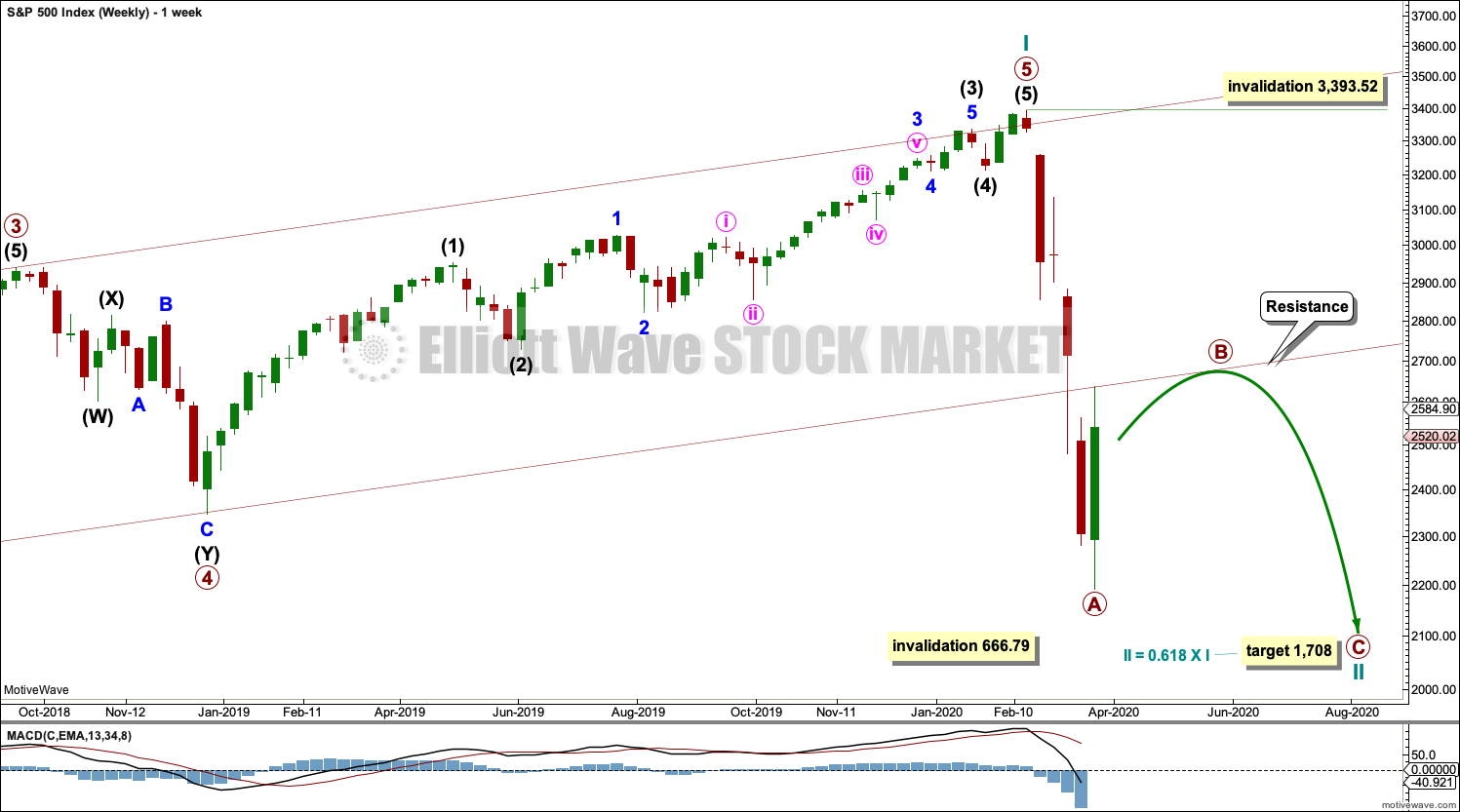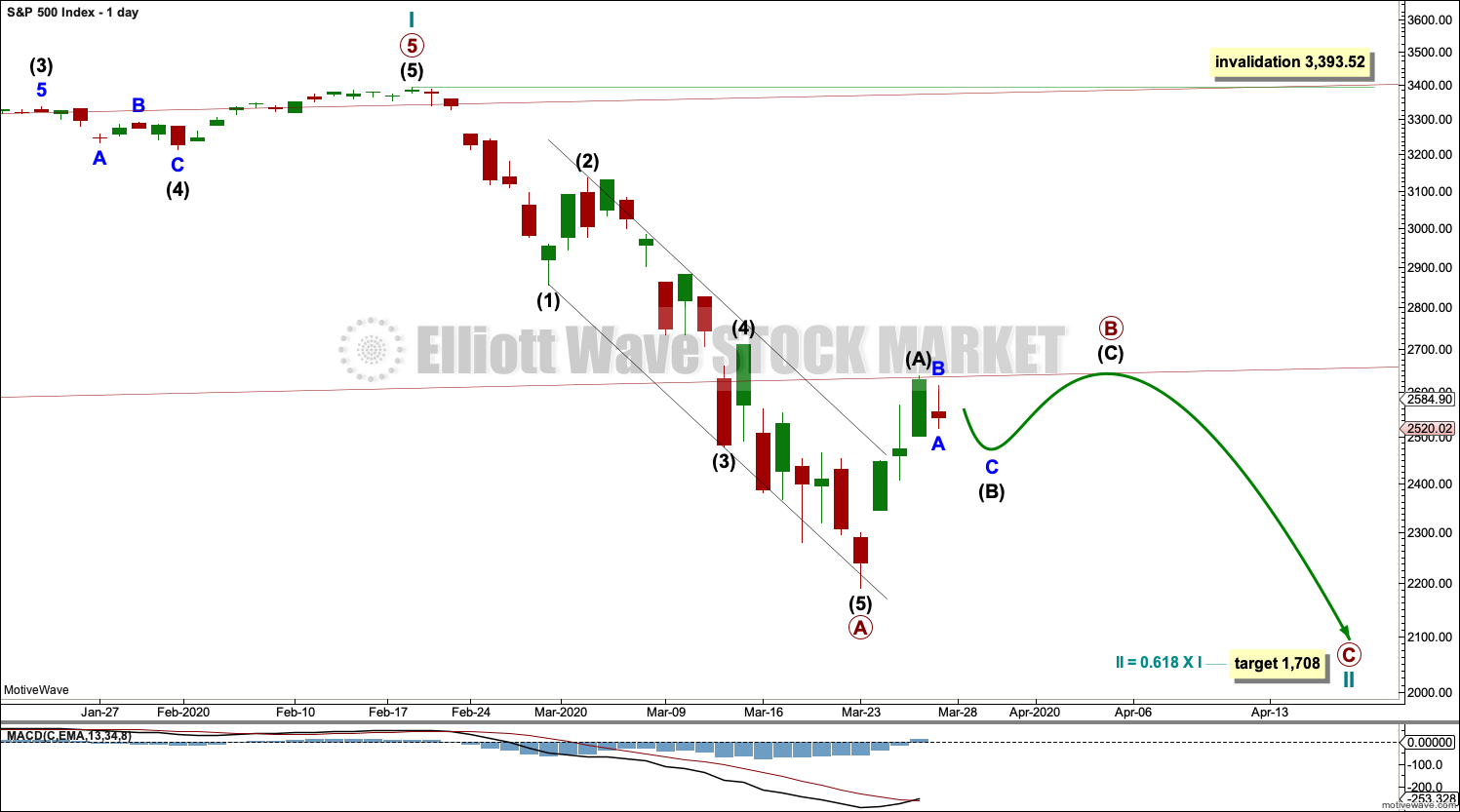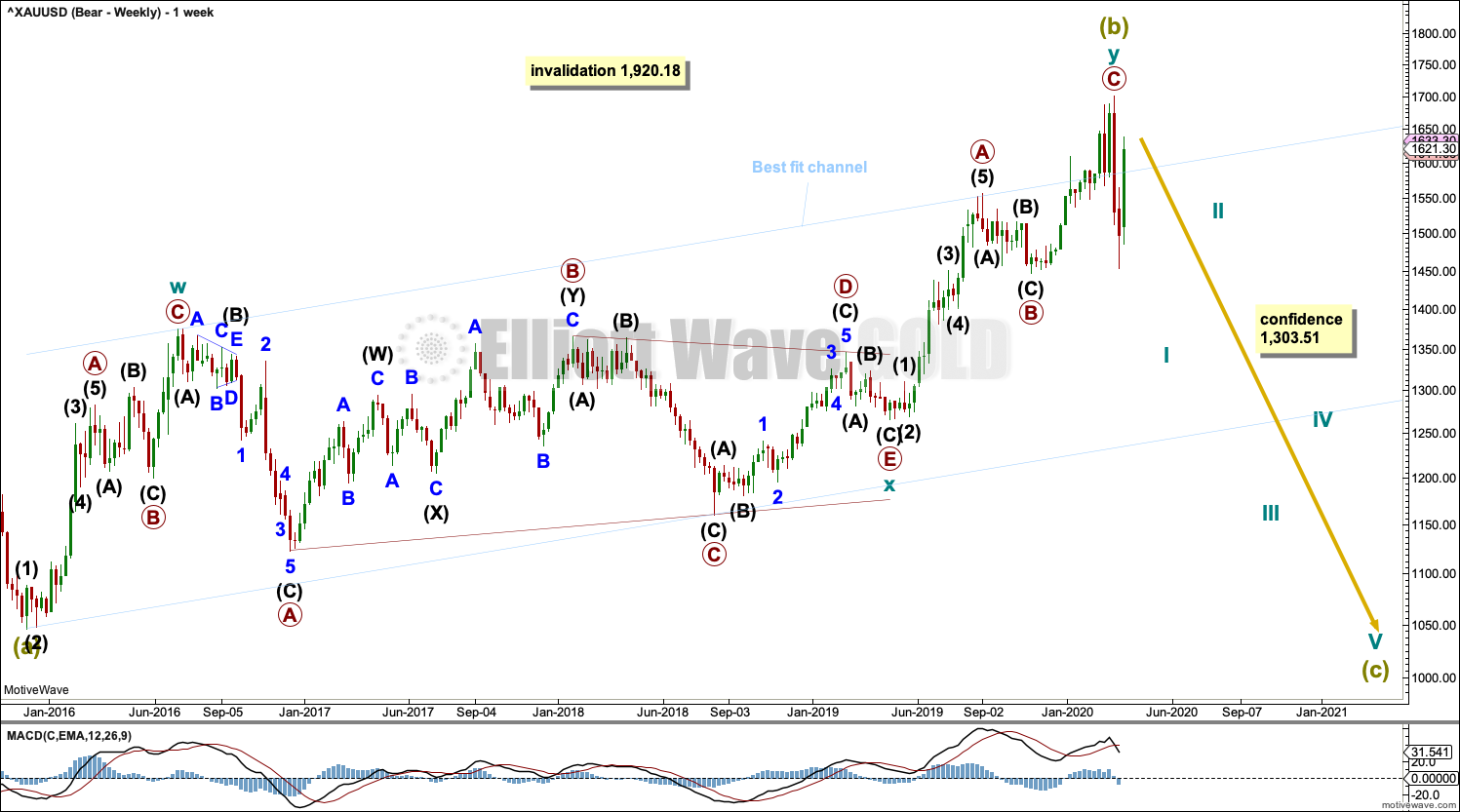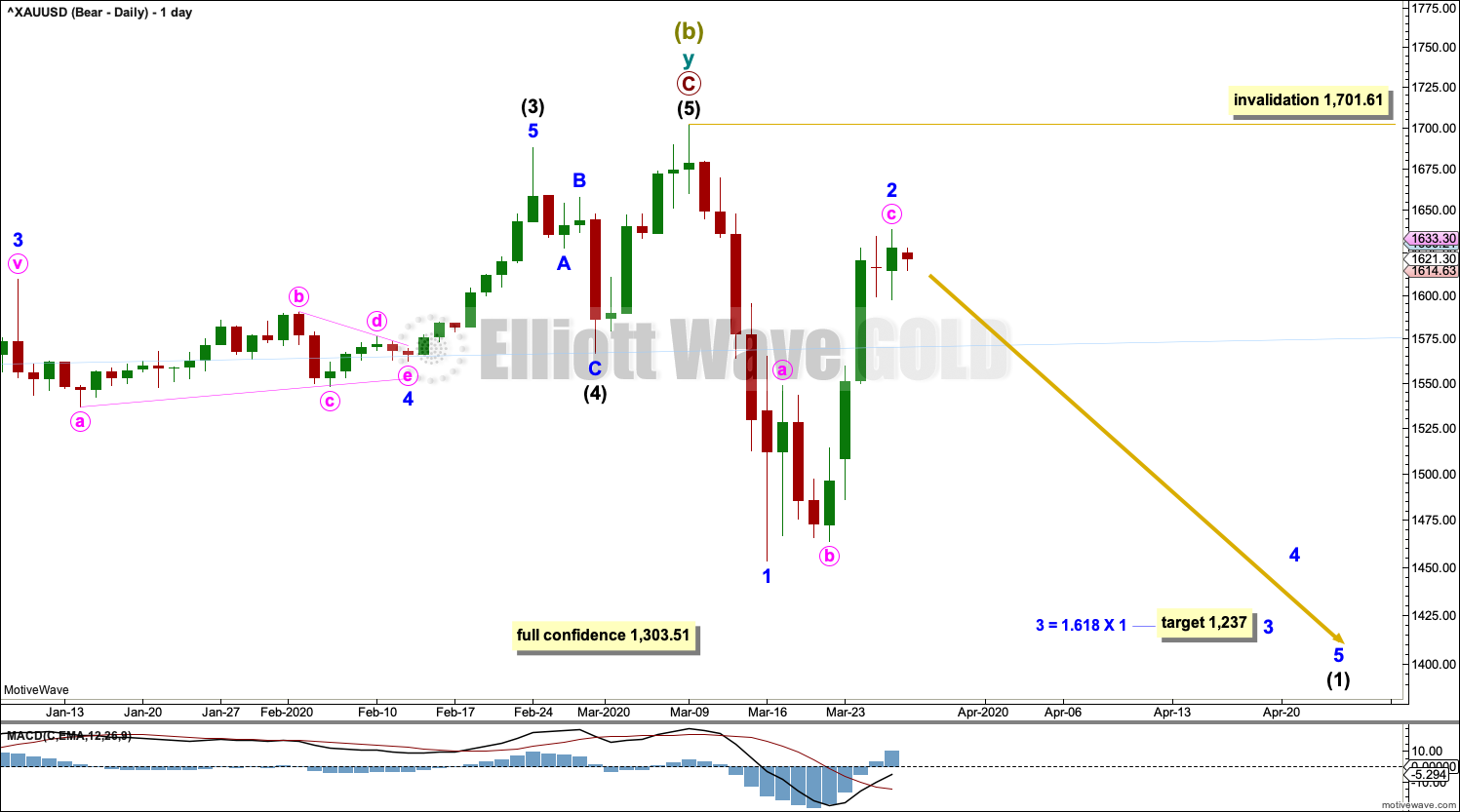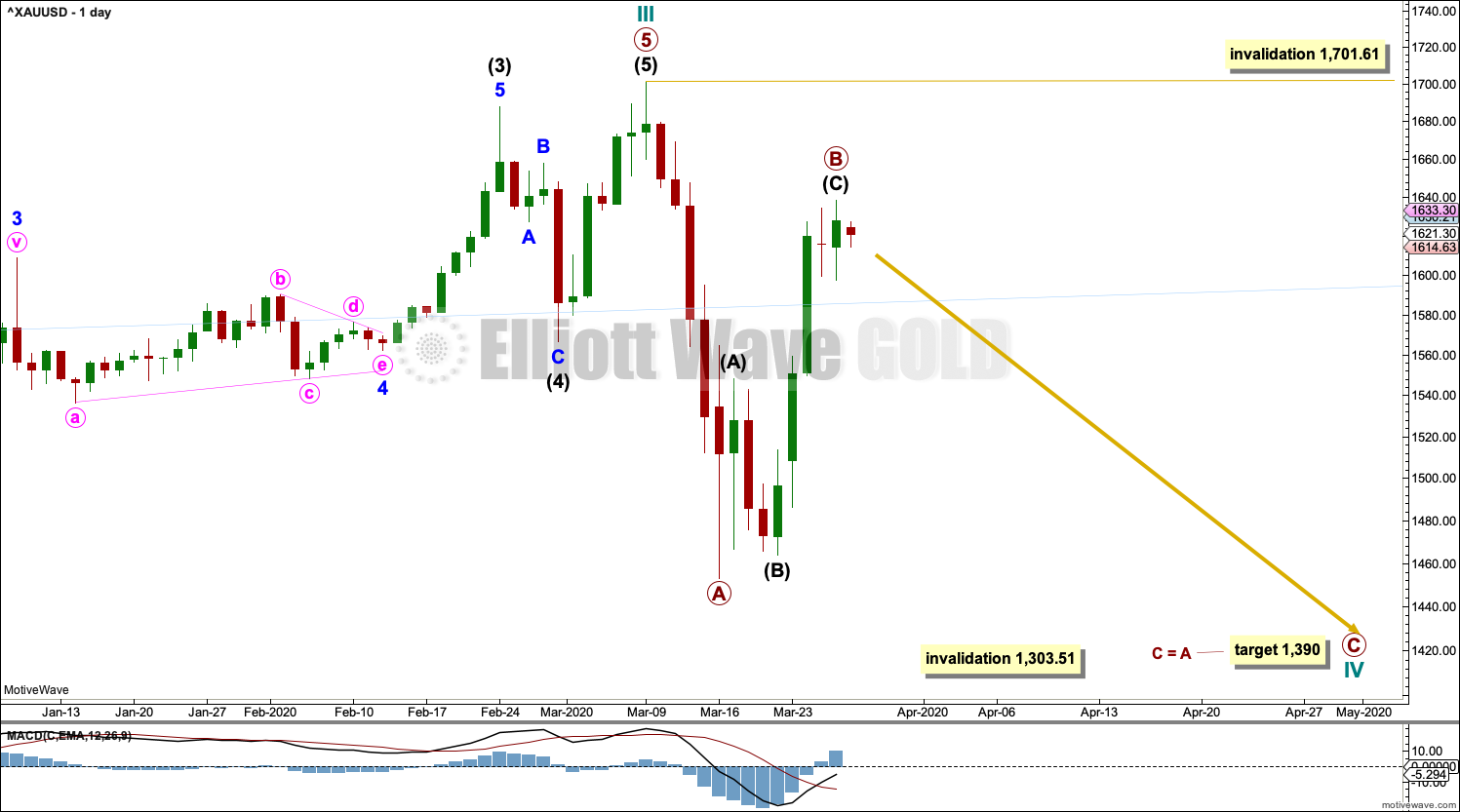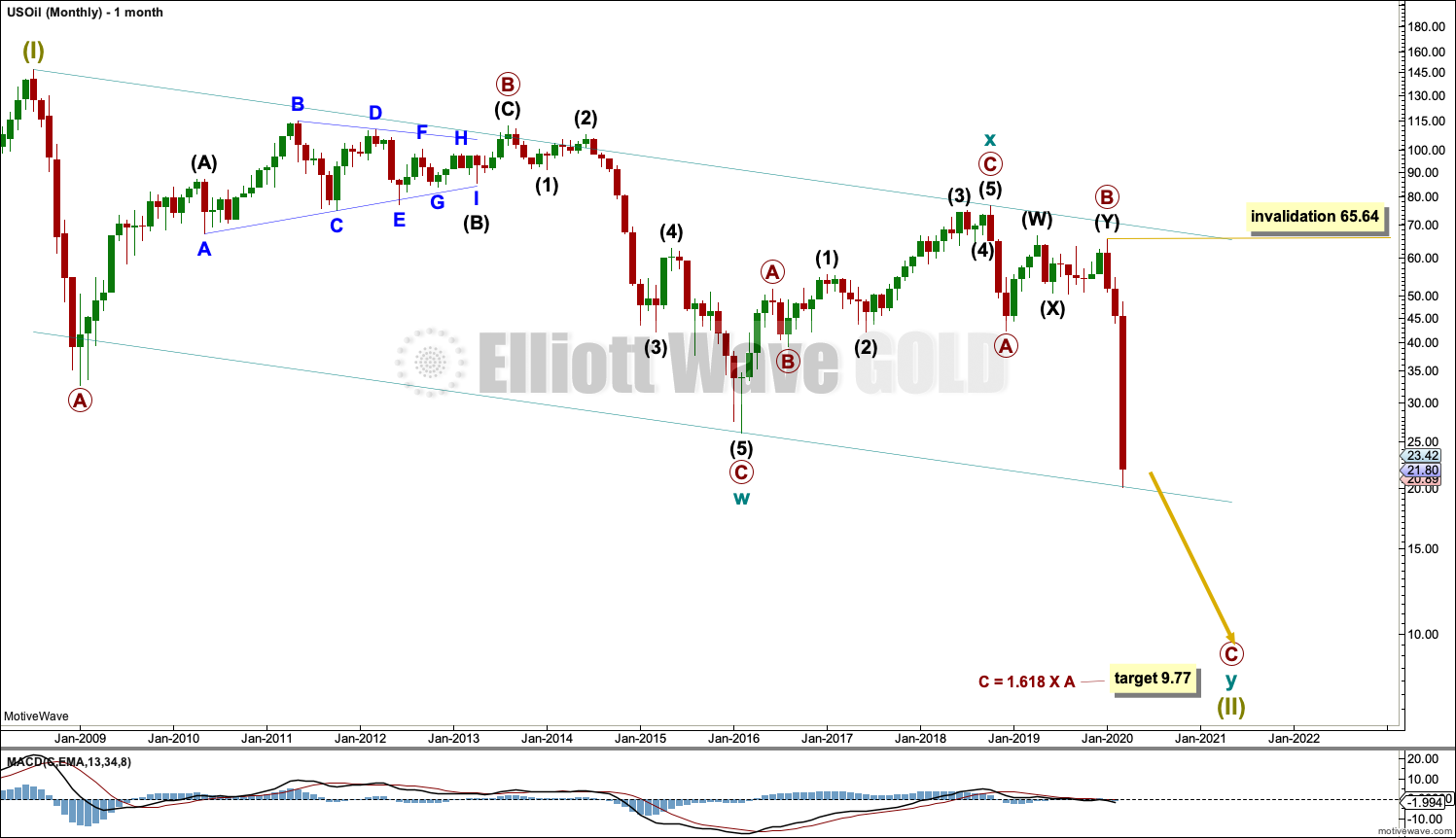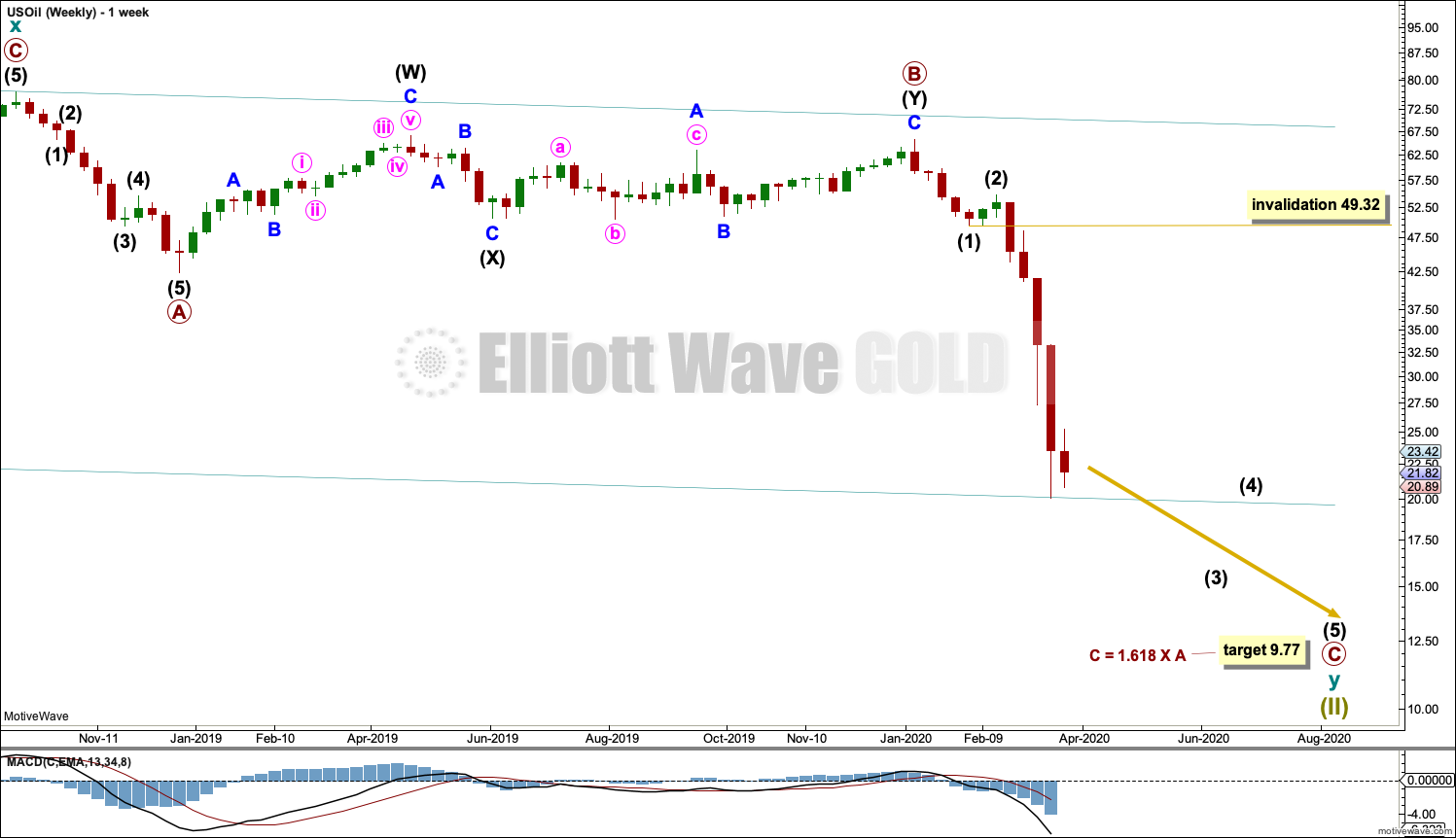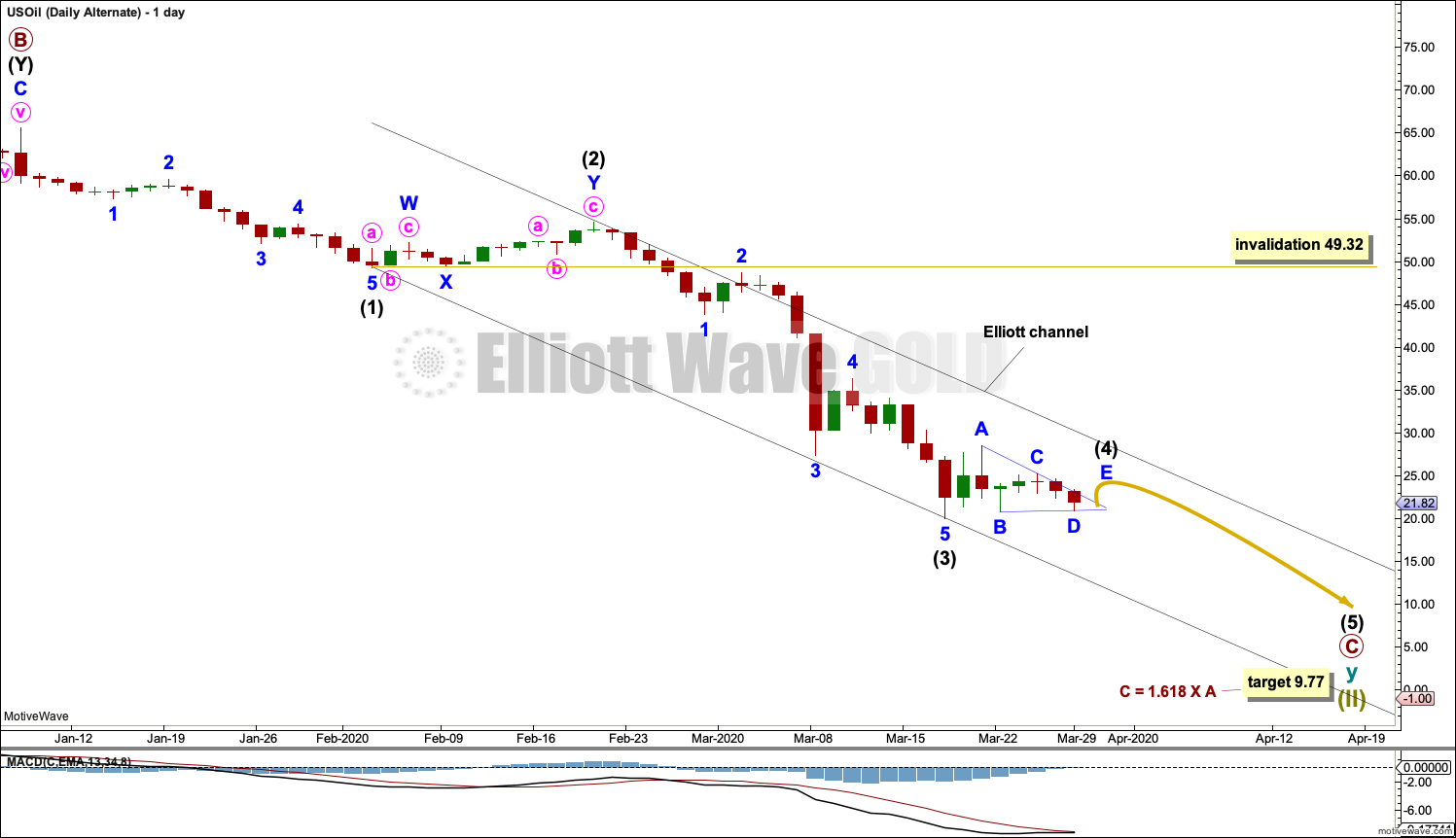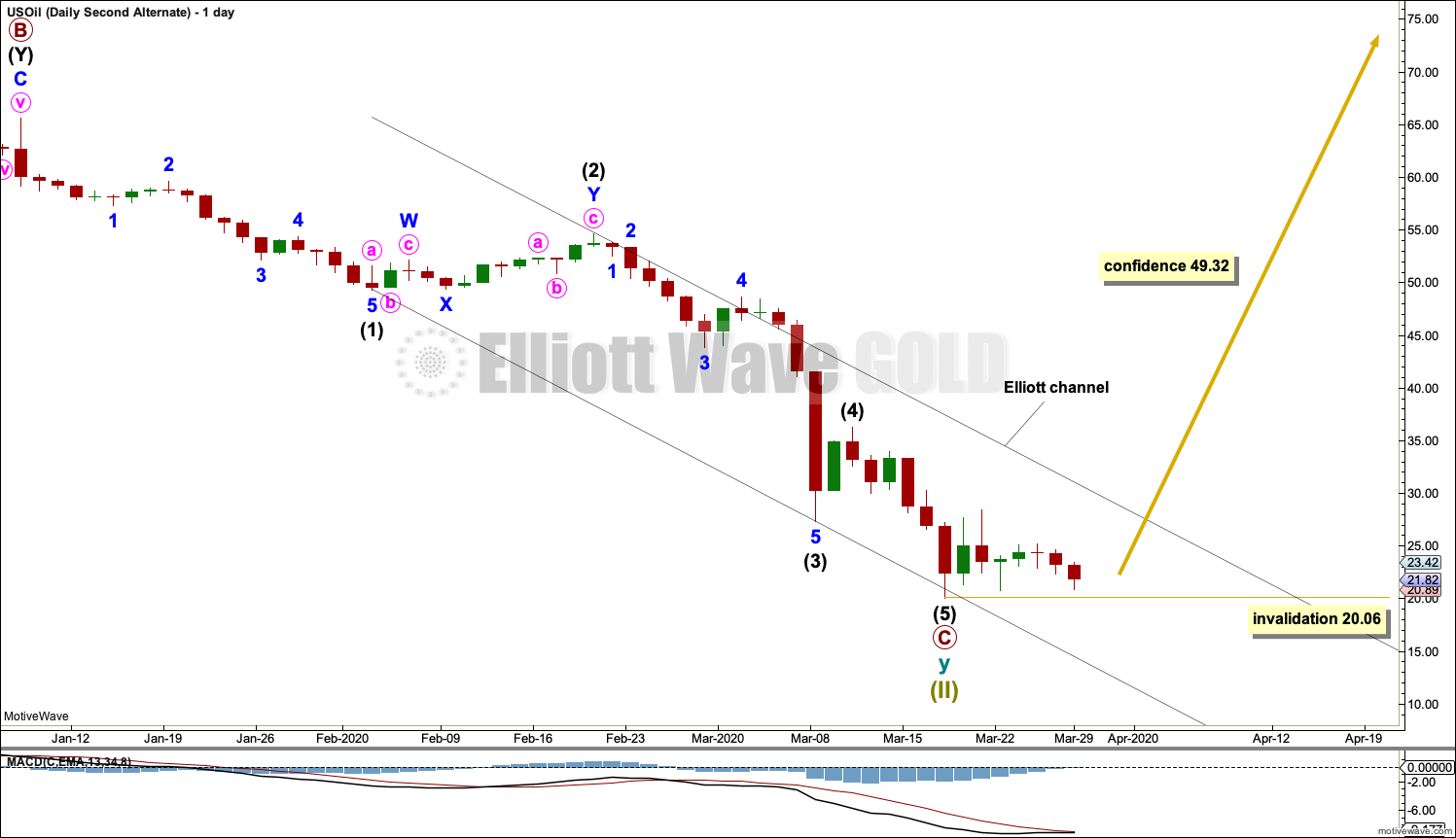Lara’s Weekly: Elliott Wave and Technical Analysis of S&P500 and Gold and US Oil | Charts – March 27, 2020

S&P 500
The session has closed red completing an inside day.
Summary: Primary wave B may have begun. It may be either a quick sharp bounce or a long lasting sideways consolidation, which will be labelled primary wave B. Targets are 2,651 or 2,934.
Next week expect downwards or sideways movement as intermediate (B) within primary wave B unfolds. Thereafter, expect the bounce to continue to targets.
The biggest picture, Grand Super Cycle analysis, is here.
Last monthly charts are here. Video is here. Members are encouraged to view all three monthly charts. The third is much more bearish than this main wave count and remains a valid possibility.
ELLIOTT WAVE COUNTS
WEEKLY CHART
The channel is now breached by a full weekly candlestick below and not touching the lower edge. Further confidence in this wave count may be had. The lower edge of this channel is this week providing resistance. It may continue to do so.
Price is now below the 0.382 Fibonacci ratio of cycle wave I at 2,352. The structure of cycle wave II may need further to go to complete. The next Fibonacci ratio at 0.618 is now a preferred target for cycle wave II to end.
Cycle wave II would most likely subdivide as a zigzag; thus far that looks like what it is unfolding. When primary waves A and B may both be complete, then the target may be calculated using a Fibonacci ratio between primary waves A and C. At that stage, the final target may change or widen to a zone.
Cycle wave II may not move beyond the start of cycle wave I below 666.79.
DAILY CHART
Redraw the wide maroon trend channel carefully: draw the first trend line from the end of primary wave 1 at 2,093.55 (December 26, 2014), to the end of primary wave 3 at 2,940.91 (September 21, 2018), then place a parallel copy on the end of primary wave 2 at 1,810.10 (February 11, 2016). The channel is fully breached indicating a trend change from the multi-year bull trend to a new bear trend. The lower edge may now be an important line of resistance.
Cycle wave II may subdivide as any Elliott wave corrective structure except a triangle. It would most likely be a zigzag. Primary wave A may be a complete five wave impulse. Primary wave B may not move beyond the start of primary wave A above 3,393.52.
TECHNICAL ANALYSIS
WEEKLY CHART
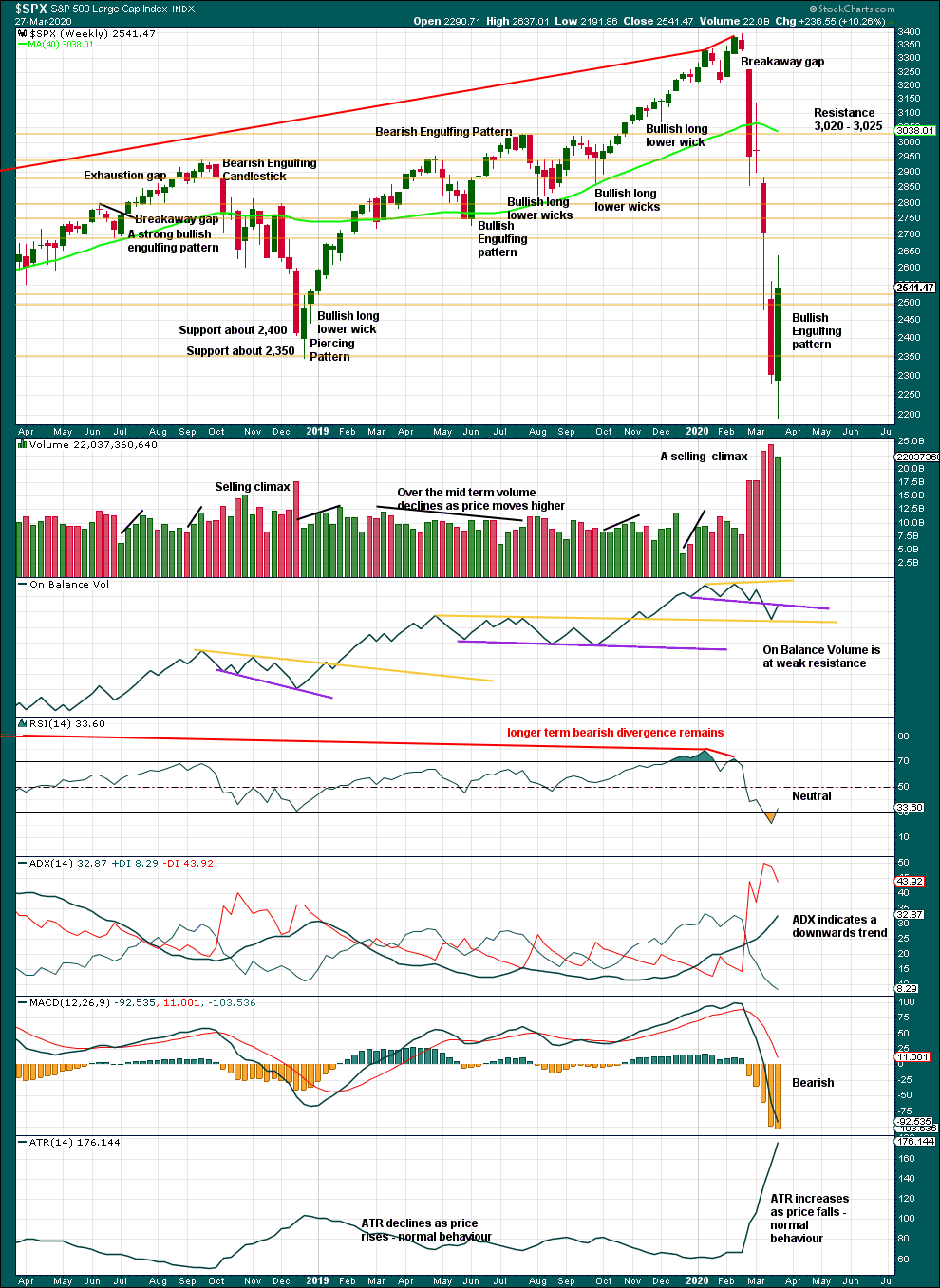
Click chart to enlarge. Chart courtesy of StockCharts.com.
A bounce has arrived within the bear market. It may continue further.
DAILY CHART
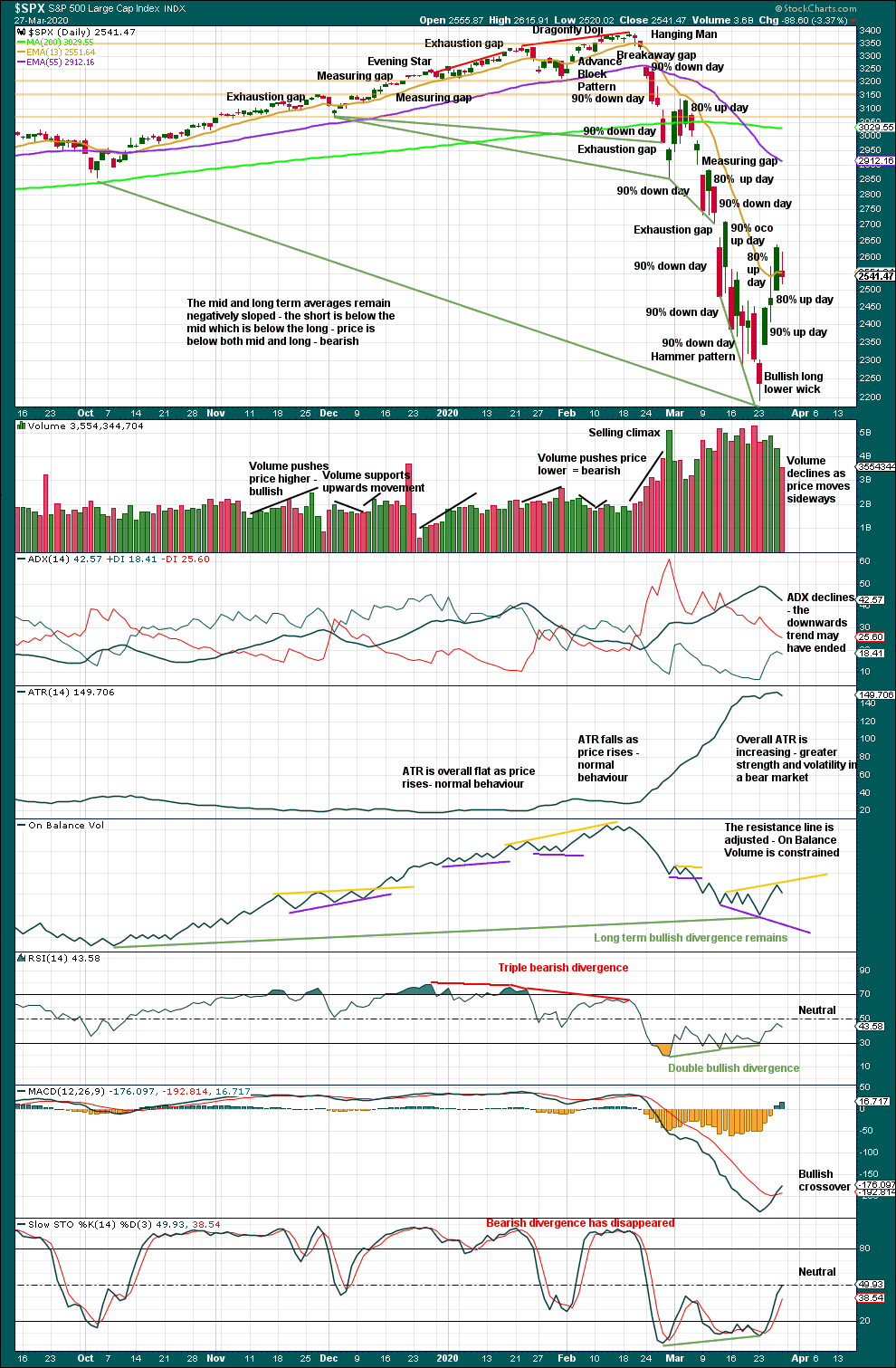
Click chart to enlarge. Chart courtesy of StockCharts.com.
There are now eight 90% downwards days in this strong downwards movement.
At the last low:
– RSI reached deeply oversold and now exhibits short-term double bullish divergence with price.
– Stochastics reached oversold and now exhibits short-term bullish divergence with price.
– On Balance Volume exhibited bullish divergence with price, although short-term bullish divergence disappeared.
Now a 90% upwards day and two back to back 80% upwards days give strong confidence that a low is in place. It may not be the end of the bear market though; the Elliott wave structure may not be complete.
A correction within the bear market looks to have arrived. It would be reasonable to expect choppy overlapping movement for at least a week or so, possibly over a month. To see what signals may be looked for to identify a high, the two previous large bear markets will be analysed below.
BREADTH – AD LINE
WEEKLY CHART
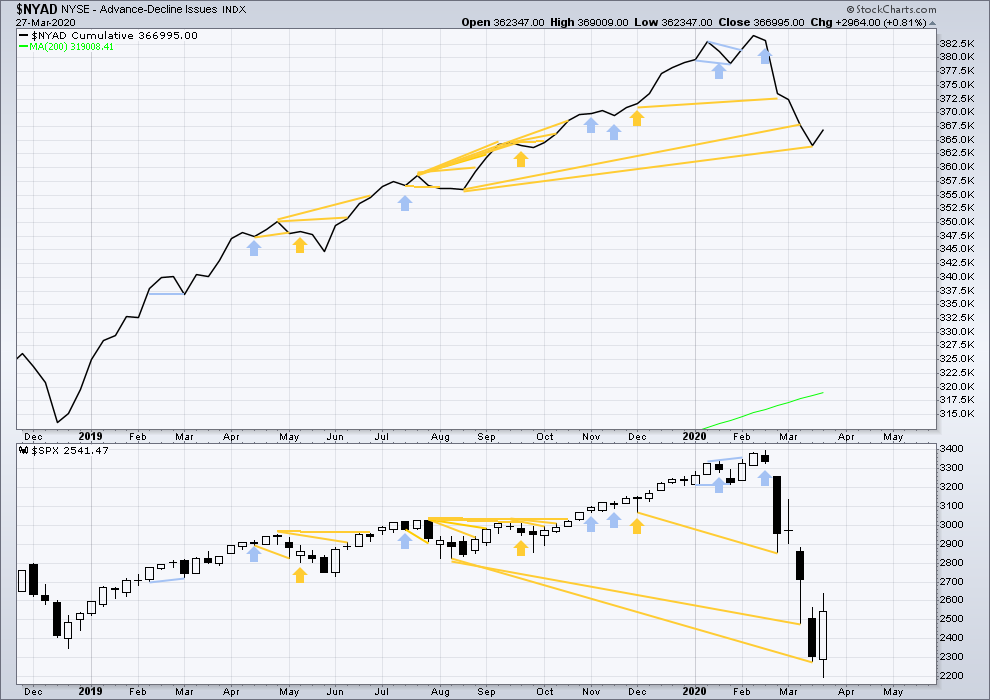
Click chart to enlarge. Chart courtesy of StockCharts.com. So that colour blind members are included, bearish signals will be noted with blue and bullish signals with yellow.
Bear markets from the Great Depression and onwards have been preceded by an average minimum of 4 months divergence between price and the AD line with only two exceptions in 1946 and 1976. With no divergence between the AD line and price at the last all time high, this current bear market now makes a third exception.
In all bear markets in the last 90 years there is some positive correlation (0.6022) between the length of bearish divergence and the depth of the following bear market. No to little divergence is correlated with more shallow bear markets. Longer divergence is correlated with deeper bear markets.
This bear market comes after no bearish divergence. It would more likely be shallow, but this is a statement of probability and not certainty. So far it is slightly more than the 0.382 Fibonacci ratio of the bull market it is correcting (beginning March 2009).
This week an outside week closes green and the AD line supports upwards movement within the week. There is no new divergence.
Large caps all time high: 3,393.52 on 19th February 2020.
Mid caps all time high: 2,109.43 on 20th February 2020.
Small caps all time high: 1,100.58 on 27th August 2018.
DAILY CHART
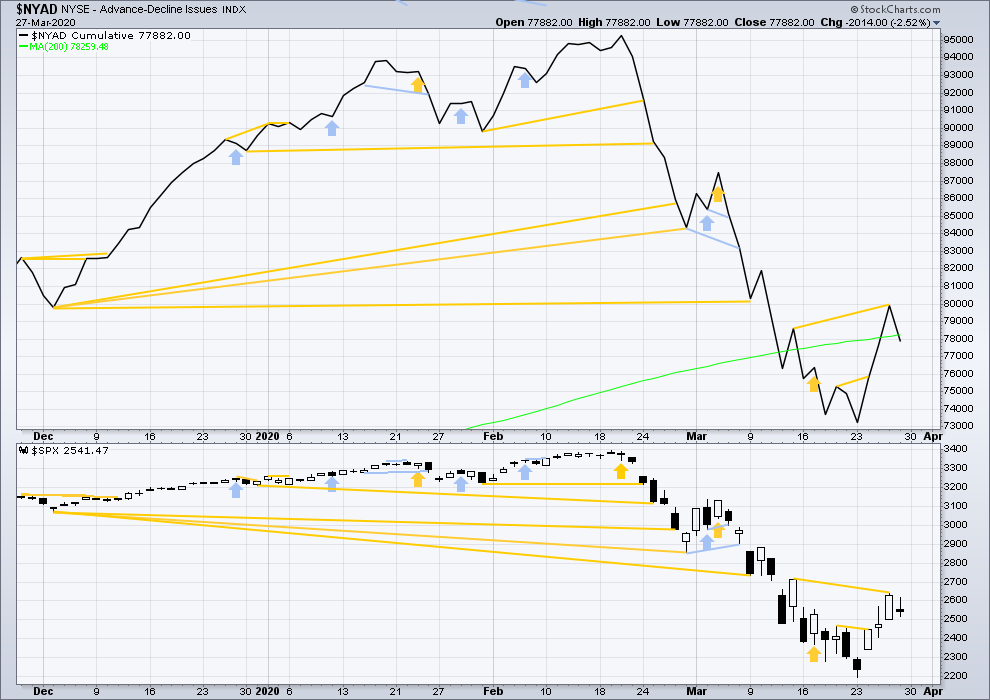
Click chart to enlarge. Chart courtesy of StockCharts.com. So that colour blind members are included, bearish signals will be noted with blue and bullish signals with yellow.
Breadth should be read as a leading indicator.
To end the week both price and the AD line moved overall lower during Friday. There is no new short-term divergence.
VOLATILITY – INVERTED VIX CHART
WEEKLY CHART
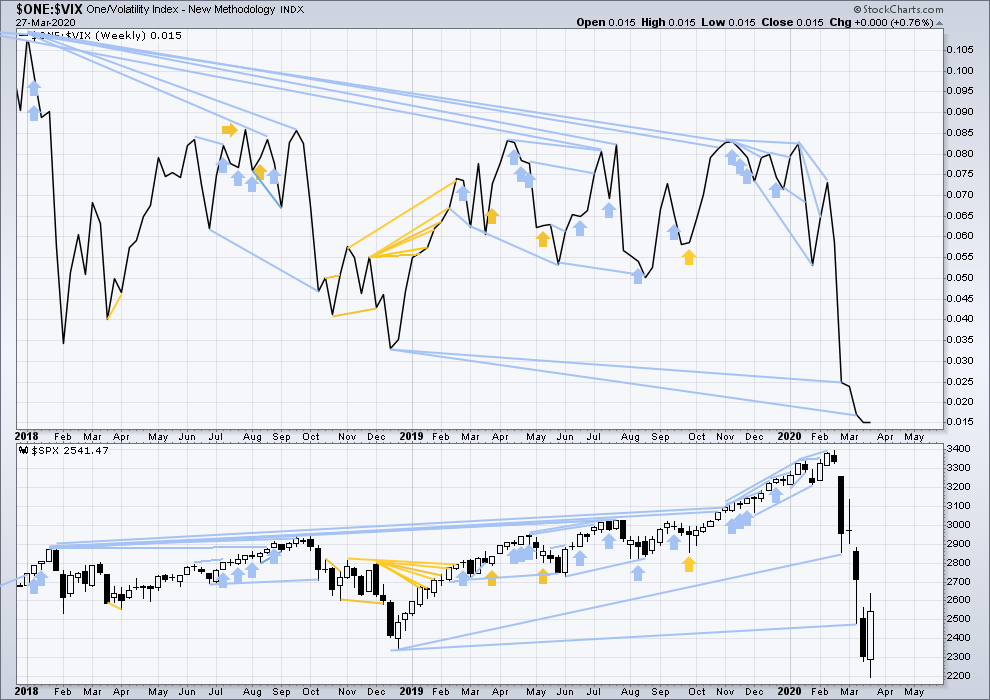
Click chart to enlarge. Chart courtesy of StockCharts.com. So that colour blind members are included, bearish signals will be noted with blue and bullish signals with yellow.
This week completes an outside week, which has closed green, and inverted VIX is overall flat. There is no new short-term divergence.
DAILY CHART
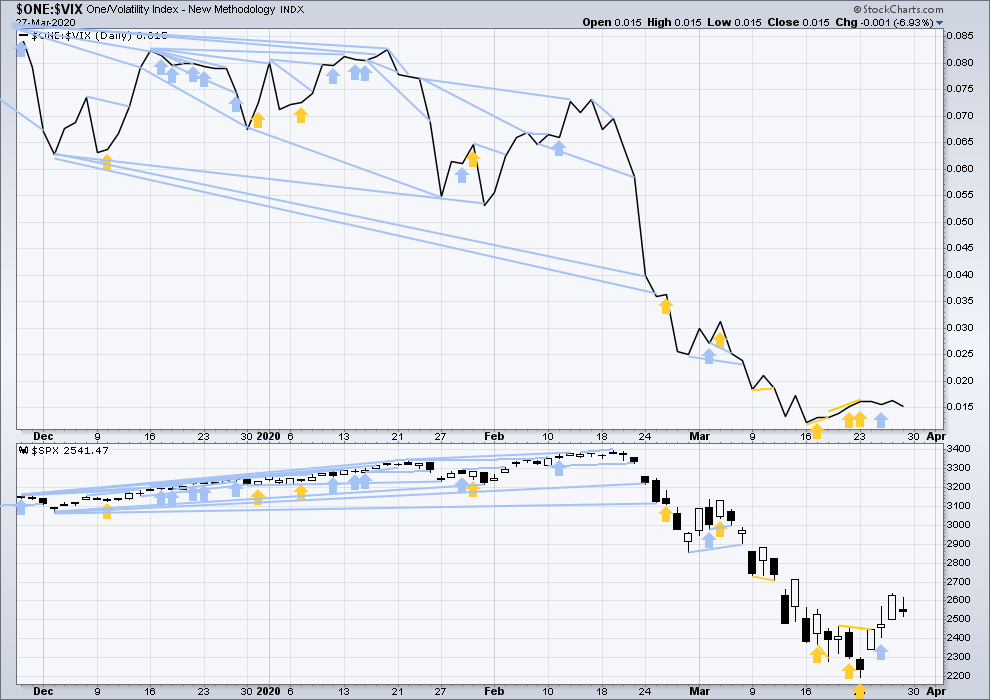
Click chart to enlarge. Chart courtesy of StockCharts.com. So that colour blind members are included, bearish signals will be noted with blue and bullish signals with yellow.
On Friday price moved overall lower and inverted VIX has slightly declined. There is no new divergence.
DOW THEORY
Dow Theory has confirmed a bear market with the following lows made on a closing basis:
DJIA: 21,712.53 – a close below this point has been made on the March 12, 2020.
DJT: 8,636.79 – a close below this point has been made on March 9, 2020.
Adding in the S&P and Nasdaq for an extended Dow Theory, a bear market has now been confirmed:
S&P500: 2,346.58 – a close below this point has now been made on March 20, 2020.
Nasdaq: 7,292.22 – a close below this point was made on the March 12, 2020.
ANALYSIS OF CORRECTIONS WITHIN BEAR MARKETS
FIRST HISTORICAL EXAMPLE: DOTCOM CRASH: MARCH 2000 – OCTOBER 2002
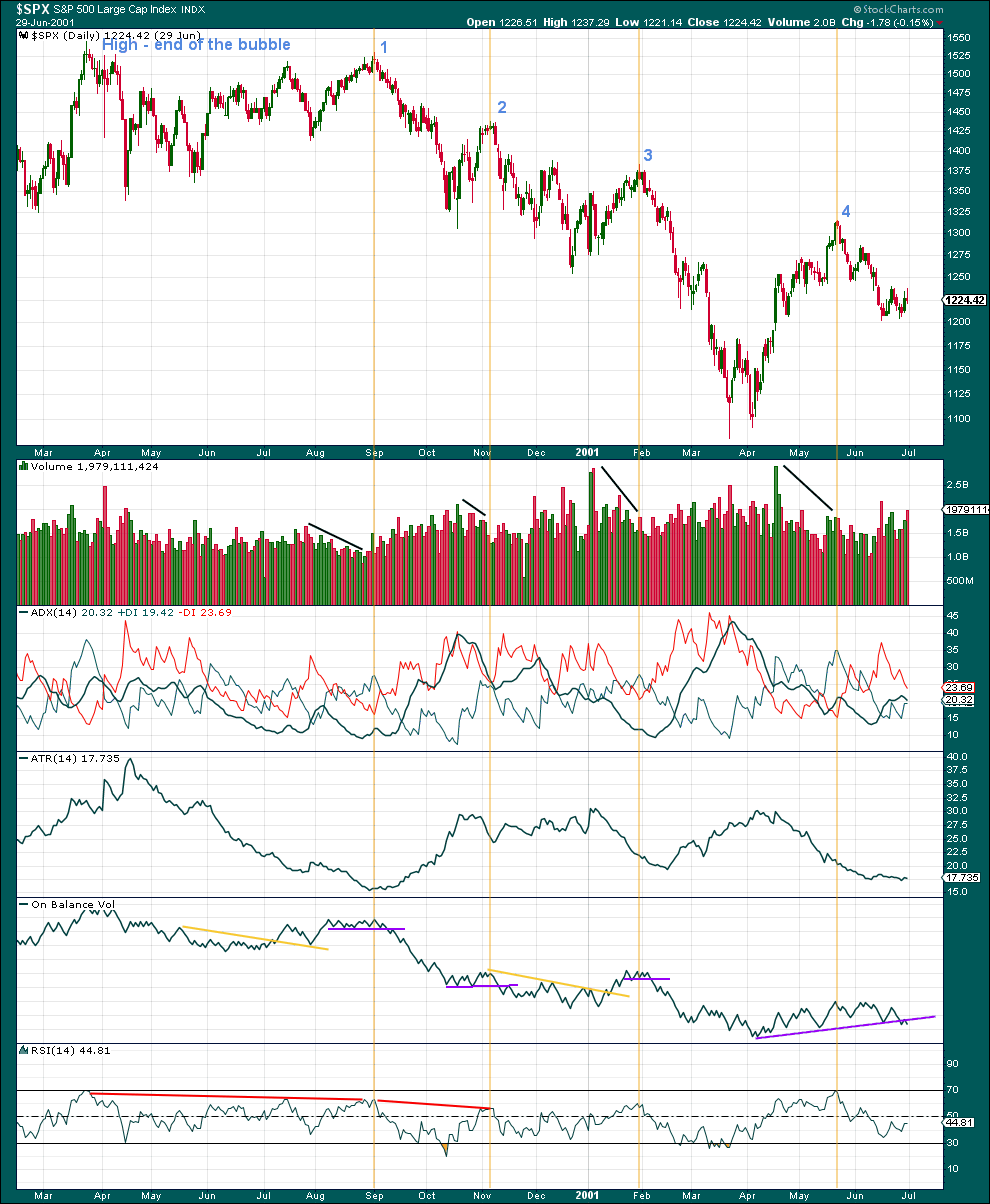
Click chart to enlarge. Chart courtesy of StockCharts.com.
This first chart looks at the first half of the Dotcom crash. Several bounces are noted. Each is analysed below:
1. Ended September 1, 2000. The bounce lasted 97 days. An Evening Doji Star at the end; volume declined throughout but spiked on the final high; ADX indicated an upwards trend in the middle and again just at the end; ATR declined throughout; On Balance Volume did not confirm highs as it was flat while price was rising and then gave a bearish signal on the 12th of September; RSI exhibited weak bearish divergence at the high.
2. Ended November 5, 2000. The bounce lasted 13 days. A large Bearish Engulfing pattern two days after the high on the 8th of November; volume declined throughout; ADX declined throughout; ATR began flat and then declined at the end; On Balance Volume did not confirm the last two daily highs at the end and then gave a bearish signal a few days after the end on the 10th of November; RSI exhibited bearish divergence with the prior swing high labelled 1.
3. Ended January 31, 2001. The bounce lasted 26 days. A large Bearish Engulfing pattern two days after the high on the 2nd of February; volume declined throughout; ADX declined throughout; ATR declined throughout; On Balance Volume failed to confirm the last high and gave a bearish signal a few days after on the 7th of February; RSI exhibited no bearish divergence at the end.
4. Ended May 22, 2001. The bounce lasted 42 days. An Evening Star candlestick at the high; volume declined throughout; ADX exhibited a bullish trend in the middle and end; ATR declined throughout; On Balance Volume did confirm highs at the end; RSI exhibited no bearish divergence at the end.
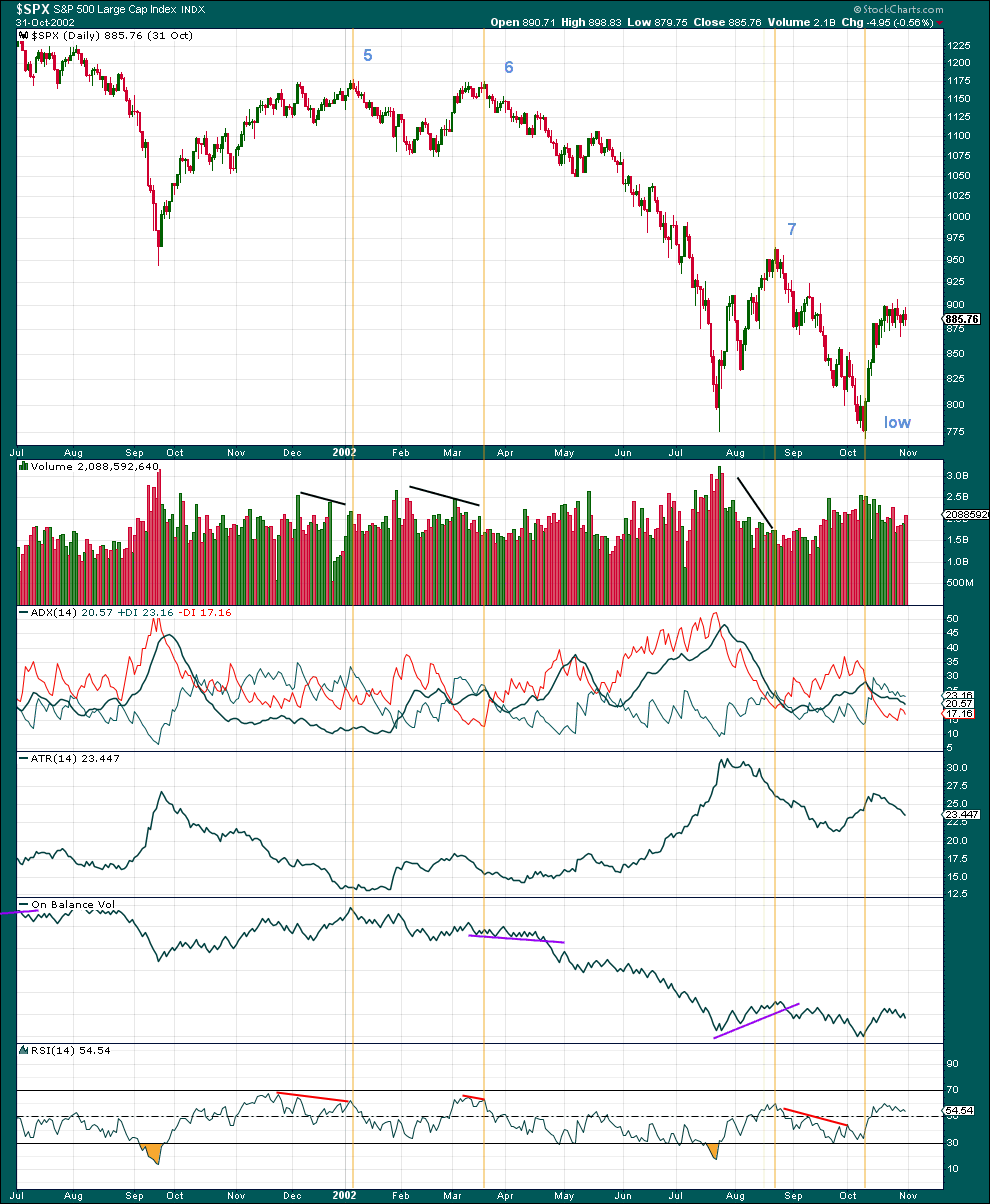
Click chart to enlarge. Chart courtesy of StockCharts.com.
This chart covers the second half of the Dotcom crash.
5. Ended January 7, 2002. (Note: my Elliott wave count labels this primary wave B within the crash). The bounce lasted 73 days. A Bearish Engulfing candlestick pattern at the high (there was one other prior within the bounce on the October 17, 2001); volume was not clear (overall, it declined throughout, but there was some increase at the end); ADX indicated an upwards trend early in the bounce but not at the end; ATR declined throughout; On Balance Volume did confirm highs at the end and gave no bearish signals; RSI exhibited single short-term bearish divergence at the end.
6. Ended March 19, 2002. The bounce lasted 17 days. A Bearish Engulfing candlestick pattern on the 20th of March; volume declined throughout; ADX indicated an upwards trend, which did not reach extreme; ATR declined only at the end; On Balance Volume did not confirm final highs; RSI exhibited single short-term bearish divergence at the end.
7. Ended August 22, 2002. The bounce lasted 21 days. Not correctly a Bearish Engulfing pattern at the end, but the candlestick of August 23rd did close well below the prior upwards session (noted that a strong Bearish Engulfing pattern occurred within the bounce on August 1st); volume strongly declined throughout; ADX strongly declined throughout; ATR declined throughout; On Balance Volume did confirm last highs and gave a bearish signal 6 days after on August 29th; RSI exhibited no bearish divergence.
Summary:
Major bounces may last at least two weeks or as much as 4 months. At the end of every bounce: There was a bearish candlestick pattern (although a few bounces also had bearish reversal patterns within them that may have given false signals of a more sustainable high in place); ATR declined throughout with one exception where it only declined at the end; in 4. and 7. On Balance Volume did not confirm new highs, but in 3. and 7. it did confirm new highs at the end; bearish signals from On Balance Volume came from a few to several days after in 4. and 7.; RSI exhibited bearish divergence in 4. and 7.
Conclusion:
The presence of a bearish candlestick pattern should be looked for.
Expect ATR to decline throughout as very likely.
Failure of On Balance Volume to confirm new highs may increase the probability of an end to the bounce, but be aware it may not do this. Any bearish signals from On Balance Volume may come a few days after a high.
If RSI exhibits short to mid-term bearish divergence at highs, the probability of a high increases.
Next end of week analysis will do the same process for the Global Financial Crisis (GFC) from October 2007 to March 2009.
GOLD
Sideways movement leaves the Elliott wave counts unchanged.
Summary: The bounce may have ended. The next target is at 1,237.
Grand SuperCycle analysis is here.
Monthly charts were last updated here.
BEARISH ELLIOTT WAVE COUNT
WEEKLY CHART
Super Cycle wave (b) may be a complete double zigzag.
The first zigzag in the double is labelled cycle wave w. The double is joined by a three in the opposite direction, a triangle labelled cycle wave x. The second zigzag in the double is labelled cycle wave y.
The purpose of the second zigzag in a double is to deepen the correction. Cycle wave y has achieved this purpose.
A wide best fit channel is added in light blue. Copy this channel over to daily charts. Price has now closed back below the upper edge of this channel.
DAILY CHART
Super Cycle wave (b) may be complete.
The second zigzag in the double, labelled cycle wave y, may be complete. There is no Fibonacci ratio between primary waves A and C.
If there was a trend change at Super Cycle degree, then a five down should develop at daily, weekly and monthly time frames. The first five down at the daily chart level will be labelled intermediate wave (1), and it may be incomplete. Within intermediate wave (1), minor wave 1 may now be complete and minor wave 2 may not move beyond the start of minor wave 1 above 1,701.61.
For Gold, the first second wave correction within a new trend is often very deep. So far minor wave 2 fits this expectation.
BULLISH ELLIOTT WAVE COUNT
WEEKLY CHART
This wave count sees the the bear market complete at the last major low for Gold on 3 December 2015.
If Gold is in a new bull market, then it should begin with a five wave structure upwards on the weekly chart.
Cycle wave I fits as a five wave impulse with reasonably proportionate corrections for primary waves 2 and 4. This resolves a previous major problem with the bullish wave count.
Cycle wave II now fits as a double flat. However, a problem arises with the relabelling of this structure. Within the first flat correction labelled primary wave W, this wave count now needs to ignore what looks like an obvious triangle from July to September 2016 (this can be seen labelled as a triangle on the bear wave count above). This movement must now be labelled as a series of overlapping first and second waves.
Within the first flat correction labelled primary wave W of the double flat of cycle wave II, intermediate wave (B) is 1.69 the length of intermediate wave (A). This is longer than the common range of up to 1.38, but within an allowable guideline of up to 2. The length of intermediate wave (B) reduces the probability of this wave count.
Cycle wave III may be complete. Cycle wave IV may not move into cycle wave I price territory below 1,303.51.
DAILY CHART
Cycle wave III may be complete. Cycle wave IV may not move into cycle wave I price territory below 1,303.51.
Cycle wave II was relatively deep at 0.55 of cycle wave I. If cycle wave IV exhibits alternation in depth, it may more likely be shallow; the first target at 0.382 of cycle wave III would be preferred.
Cycle wave II was a very long lasting double combination. It lasted 119 weeks. Cycle wave IV may most likely be a zigzag, which tend to be quicker structures, but it would still be expected to last several months.
TECHNICAL ANALYSIS
WEEKLY CHART

Click chart to enlarge. Chart courtesy of StockCharts.com.
The last Bearish Engulfing pattern is extreme. The pattern fully engulfs the prior nine weekly candlesticks, and it has some support from volume. This strongly indicates a trend change after the upwards trend reached very extreme and conditions reached overbought and exhibited bearish divergence.
Price does not move in straight lines. Look out for bounces and consolidations on the way down. The first major bounce within a new trend for Gold is often very deep. That may be what has happened this week. It may now be over. This week with weak volume and a long upper wick looks bearish so far.
DAILY CHART
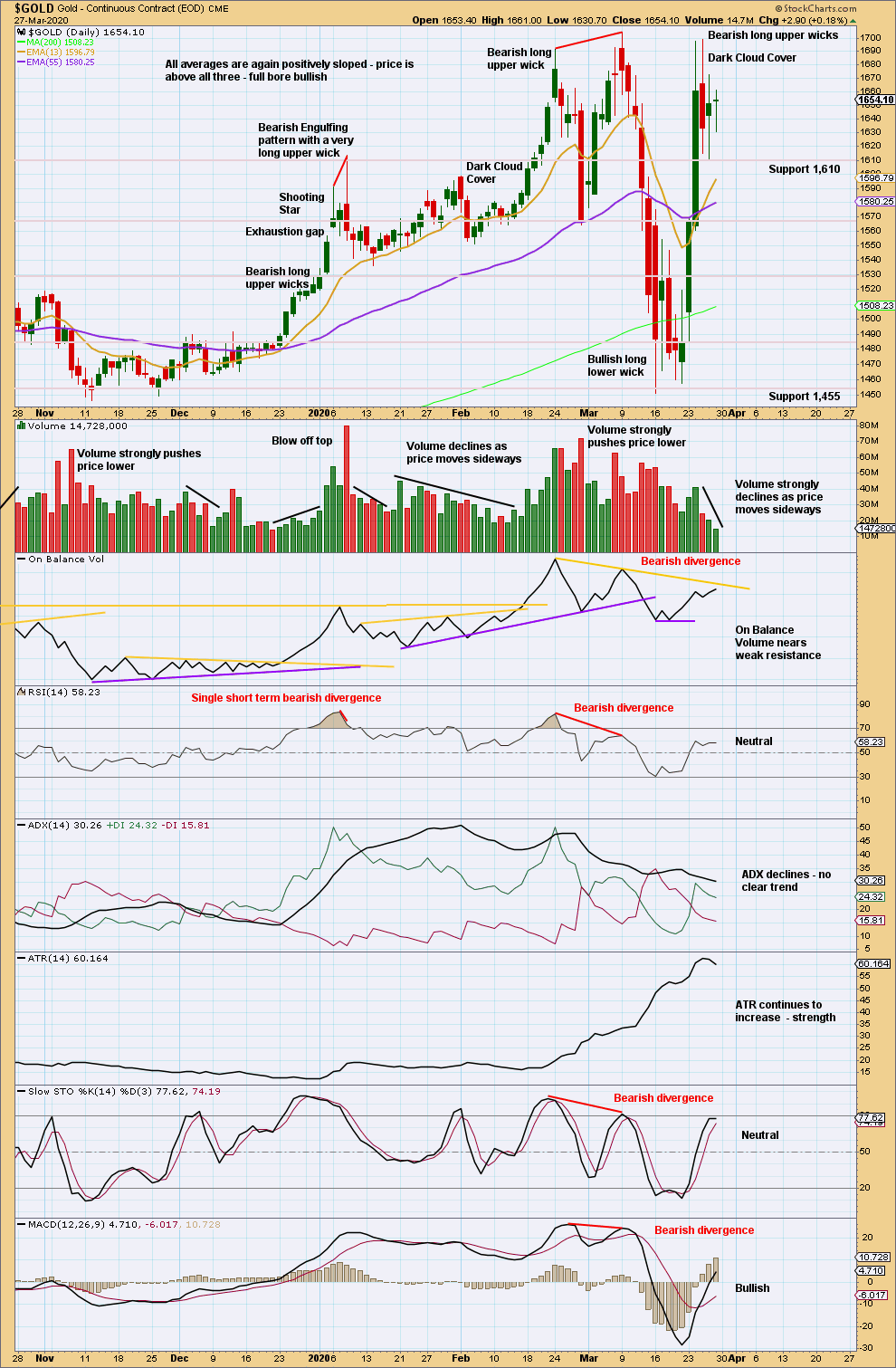
Click chart to enlarge. Chart courtesy of StockCharts.com.
Two bearish long upper wicks, weak volume for upwards sessions, and a bearish candlestick reversal pattern are together a warning that this bounce may be over. Now sideways movement in a very small range may be a pause within the trend.
GDX WEEKLY CHART

Click chart to enlarge. Chart courtesy of StockCharts.com.
There is support below in a zone about 16.75 to 15.85. Price has bounced up strongly again within this zone.
Weak volume and a long upper wick this week suggest a bounce may be over for GDX.
GDX DAILY CHART
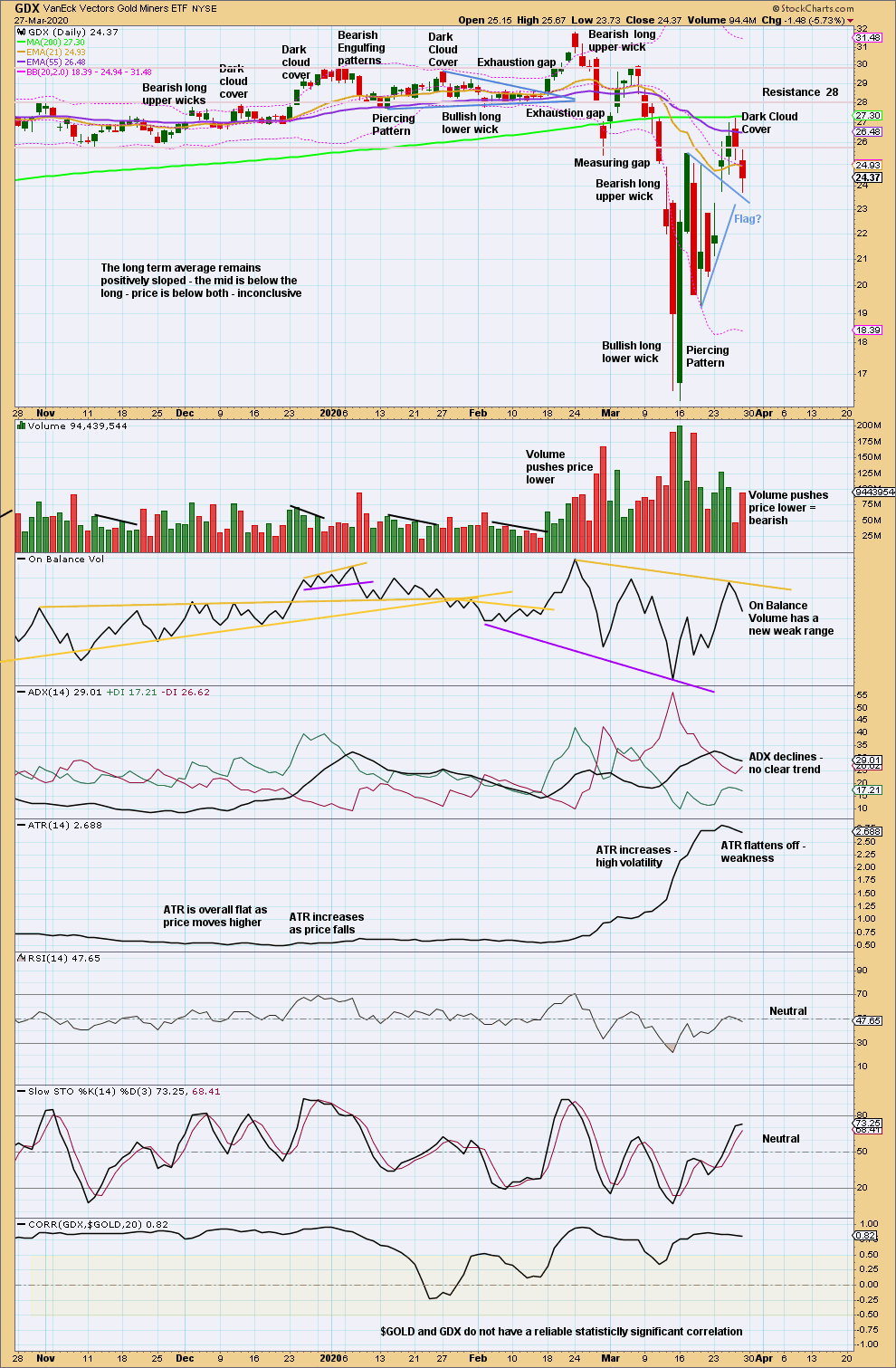
Click chart to enlarge. Chart courtesy of StockCharts.com.
There has been a trend change to downwards. This trend has support from volume pushing price lower and exhibits strength in increasing ATR.
The 55 day moving average has crossed below the 200 day moving average. This is fairly bearish.
A target from the flag pattern would be 33.58. But the pattern is not a strong one, so the target may not be met.
Upwards movement out of the flag now lacks support from volume and has a smaller range. This may be a counter trend movement. A bearish candlestick reversal pattern supports this view. The bounce may be over.
US OIL
A very small range inside week leaves the Elliott wave count mostly unchanged and the final target the same.
Summary: A short to mid-term target for intermediate wave (3) is at 11.92. Intermediate wave (4) may be a multi-day interruption to the downwards trend. Thereafter, the downwards trend may resume to a final target at 9.77.
A new high now above the upper edge of the black channel on all daily charts would suggest it could be possible a sustainable low may be in place. This view would require a new high above 49.32 for confidence.
MAIN ELLIOTT WAVE COUNT – BEARISH
MONTHLY CHART
The basic Elliott wave structure is five steps forward and three steps back. This Elliott wave count expects that US Oil is still within a three steps back pattern, which began in July 2008. The Elliott wave count expects that the bear market for US Oil continues.
This Elliott wave corrective structure is a double zigzag, which is a fairly common structure. The correction is labelled Super Cycle wave (II).
The first zigzag in the double is complete and labelled cycle wave w. The double is joined by a three in the opposite direction labelled cycle wave x, which subdivides as a zigzag. The second zigzag in the double may now have begun, labelled cycle wave y.
The purpose of a second zigzag in a double zigzag is to deepen the correction when the first zigzag does not move price deep enough. To achieve this purpose cycle wave y may be expected to move reasonably below the end of cycle wave w at 26.06. This purpose has now been achieved. The next thing to look for is a complete structure within primary wave C.
Primary wave C has passed equality in length with primary wave A at 31.11. The next Fibonacci ratio of 1.618 is used to calculate a target for primary wave C and cycle wave y to end.
Cycle wave y is expected to subdivide as a zigzag, which subdivides 5-3-5.
Cycle wave w lasted 7.6 years and cycle wave x lasted 2.7 years. Cycle wave y now looks like it may be over within a few more months.
Within primary wave C, no second wave correction may move beyond the start of its first wave above 65.64.
A channel is drawn about Super Cycle wave (II): draw the first trend line from the start of cycle wave w to the end of cycle wave x, then place a parallel copy on the end of cycle wave w. Currently, price is bouncing up off the lower edge of the channel. Currently, price has bounced weakly up off the channel. The target expects this trend line to be breached.
WEEKLY CHART
This weekly chart shows all of cycle wave y so far.
Cycle wave y is expected to subdivide as a zigzag. A zigzag subdivides 5-3-5.
Primary wave C must subdivide as a five wave motive structure, most likely an impulse. Within primary wave C, intermediate waves (1) and (2) may be complete. Intermediate wave (3) may be incomplete, or it may be complete as per the alternate daily chart below. Either way, the final target and the invalidation point for now remain the same.
Intermediate wave (4) may not move into intermediate wave (1) price territory above 49.32.
DAILY CHART
Primary wave C must subdivide as a five wave motive structure, most likely an impulse. Within primary wave C, intermediate waves (1) and (2) may now be complete.
A target is calculated for intermediate wave (3) to end.
Draw an acceleration channel about primary wave C: draw the first trend line from the end of intermediate wave (1) to the last low, then place a parallel copy on the end of intermediate wave (2). Keep redrawing the channel as price moves lower. Intermediate wave (4) may find resistance at the upper edge of the channel.
When intermediate wave (4) may be complete, then the final target may be calculated at intermediate, primary and cycle degrees. At that stage, the target may change or may widen to a zone.
ALTERNATE DAILY CHART
Alternatively, it is possible that intermediate wave (3) may be complete at the last low and intermediate wave (4) may be underway. Intermediate wave (4) may find resistance at the upper edge of the channel, or it may end mid way within the channel.
The final target for now remains the same. When intermediate wave (4) may be complete and the starting point for intermediate wave (5) may be known, if this wave count is correct, then the final target may be calculated at intermediate wave degree, which may change or widen to a small zone.
SECOND ALTERNATE DAILY CHART
In the spirit of considering all possibilities, it may be possible that the bear market for US Oil could now be over.
The channel is drawn in almost exactly the same way on all charts. If the bear market is over, then this channel needs to be breached by upwards movement (not sideways) for confidence in this view. A new high above 49.32 by any amount at any time frame would add substantial confidence to this alternate wave count.
Always assume the trend remains the same until proven otherwise. This wave count requires confidence before it should be seriously considered.
TECHNICAL ANALYSIS
MONTHLY CHART
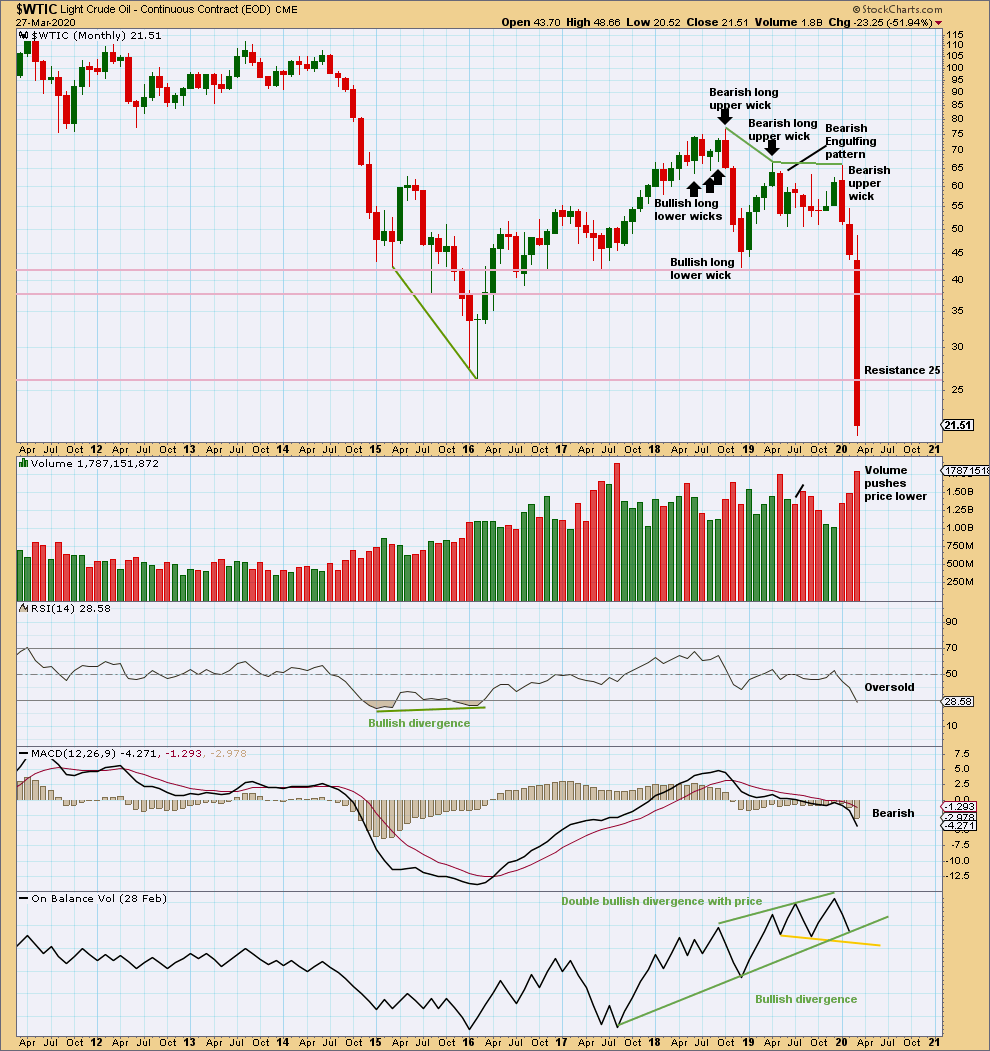
Click chart to enlarge. Chart courtesy of StockCharts.com.
When this market trends strongly down, it can reach extreme and yet price can continue for a reasonable distance.
A sustainable low may not yet be in place. Look for RSI to reach more deeply oversold and then to exhibit bullish divergence with price at swing lows.
WEEKLY CHART
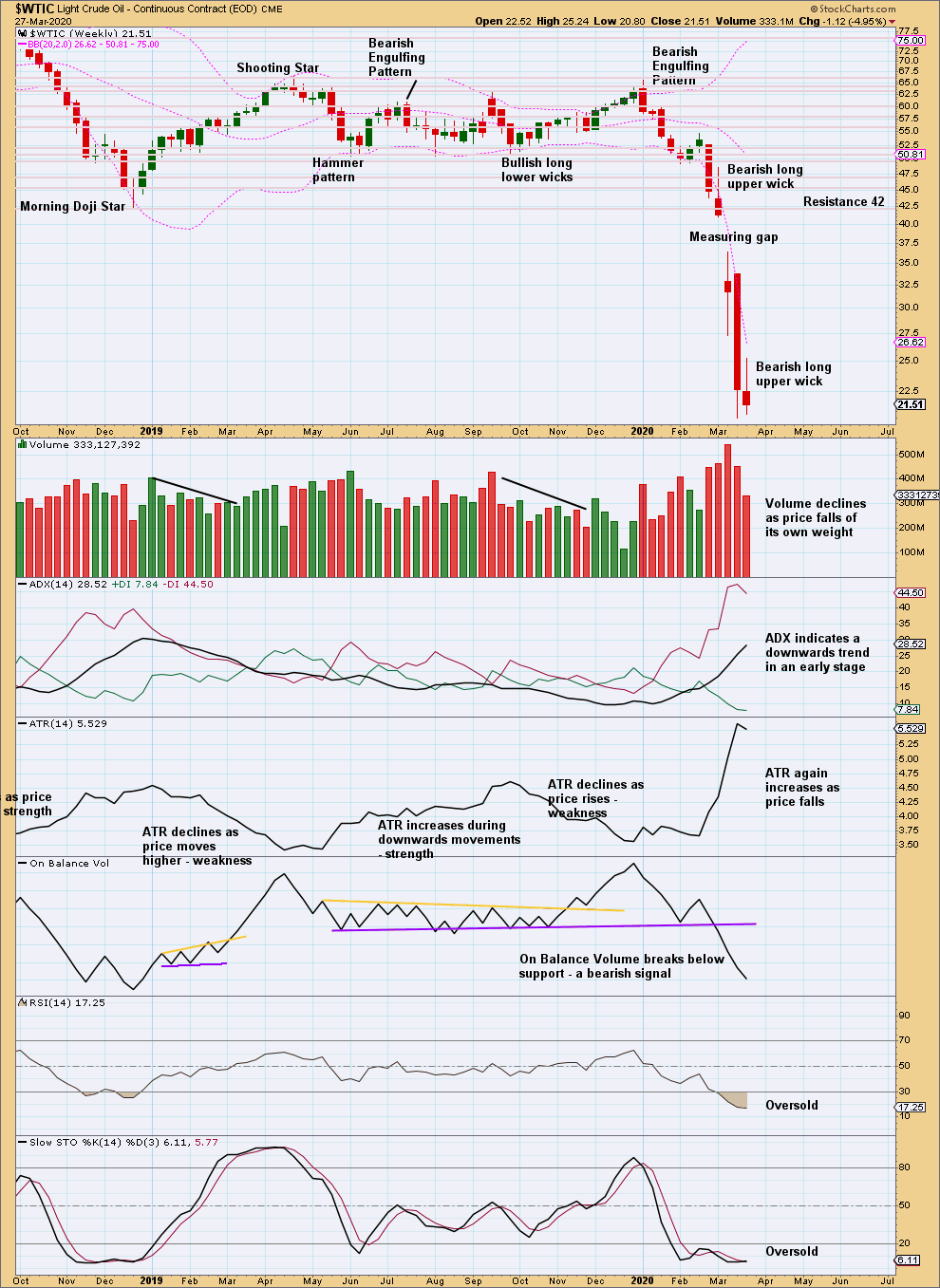
Click chart to enlarge. Chart courtesy of StockCharts.com.
This measuring gap gives a target at 22.74, which has now been met and slightly exceeded. A bounce may develop about here. This view is outlined by the alternate daily chart this week.
Overall, expect the downwards trend to continue (but keep in mind price does not move in straight lines).
DAILY CHART

Click chart to enlarge. Chart courtesy of StockCharts.com.
A downwards trend is now in place at all time frames. Both volume and range support this trend.
RSI and Stochastics may remain very extreme for reasonable periods of time when this market trends. ADX may also remain very extreme for reasonable periods of time.
Bullish divergence between price and RSI is too weak to indicate a sustainable low.
—
Always practice good risk management as the most important aspect of trading. Always trade with stops and invest only 1-5% of equity on any one trade. Failure to manage risk is the most common mistake new traders make.

